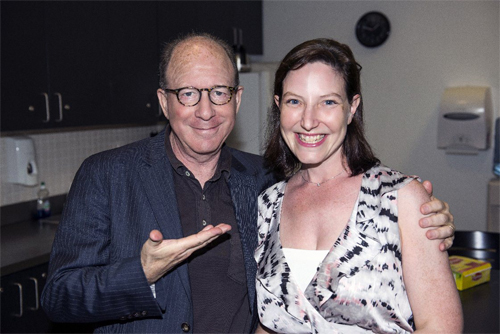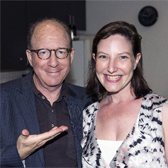Post by Bonnie Silvestri

Jerry Saltz, Senior Art Critic for New York magazine, wants you to like him—but only if you are willing to engage in a dialogue about art. When I got the opportunity to sit down with this charming and self-effacing art critic extraordinaire, I was immediately swept up in his love of art, writing and conversation. Saltz was part of a panel of experts in a Creative Conversation on contemporary art in America during the Greenfield Prize Weekend for the Hermitage Artist Retreat. He gave the keynote address at the Greenfield Prize dinner, where artist Trenton Doyle Hancock received the 2013 award.
was already a fan of Saltz from his weekly appearances on Bravo’s TV show Work of Art, a reality show seeking the next top artist. He was widely criticized for pandering to the public and derided for “destroying art” in becoming a part of the show, and I liked that he was willing to continue in spite of his detractors. But his on-screen persona was a bit edgy. What I didn’t know was that he would be so easy-going and spirited in person and that we would be so squarely on the same page that the arts need to become more accessible.
The art world, especially the gallery scene in New York City, often gets a bad rap. Outside the tiny circle of artists, gallerists, curators and collectors, contemporary art can seem like an impenetrable wall to the general public. But Saltz is dedicated to tearing down that wall. In contrast to his detractors, Saltz believes that “art will do just fine” if it becomes more democratized.
“All you good little humanists, you want art to be understood and embraced by the public,” Saltz said, but then these same folks panic the minute the process of art making and art criticism is opened up for popular consumption.
To some extent, Saltz is a one-man show who allows art criticism to “cross this divide” between art makers and art consumers. In addition to his work for the magazine, he lectures regularly for art programs of the top universities in the country. Perhaps it is his training as an educator that makes him want to go beyond the confines of the four corners of his magazine. He responded with a personal note to every person who commented on his Work of Art recap blogs, which in the end garnered over 100,000 comments. Furthermore, Saltz said he resisted the magazine’s attempt to put up a firewall between him and his audience because he doesn’t want to “dance naked” alone. He wants to be understood. His “skin is like an elephant,” and he loves communicating with the public about his writing, art criticism and the art world itself.
Saltz wants to move away from the vertical model in which the art critic tells everyone else what to think about a painting, a sculpture or an exhibit, and that goes for the artists as well. Rather, he wants to create a “more horizontal platform” in which everyone has a voice in the creative process. He calls it the “40,000 headed beast” that seeks to engage in a conversation about art through online media.
“I’m not interested in power, I’m interested in credibility and in respect,” Saltz said. As he opens himself up to public critique, he makes himself a more valid critic. By pulling back the veil on the mysteries of contemporary art, he may be dragging the whole art world with him. Much like Web MD began to level the playing field in the doctor/patient relationship, Saltz has validated our particular tastes.
“My 15 percent may not overlap with your 15 percent,” Saltz said. But without public connossieur-ship, the art world may go the way of the dinosaurs. And with a richer understanding, we can begin to rely on the vehicle of the creative arts to help us communicate more meaningfully with one another. Three cheers to Saltz for taking on the establishment and winning!
******
Bonnie Silvestri is Senior Fellow for Arts, Culture and Civic Engagement and an instructor teaching law classes in the College of Arts and Sciences at the University of South Florida Sarasota-Manatee. Prior to moving to Sarasota, she lived in New York City from 1996 to 2006. She received her Bachelor of Arts magna cum laude in English with a minor in Art History from Vanderbilt University and her Juris Doctor from The Michael E. Moritz College of Law at The Ohio State University. Most importantly, she is mom to the beautiful Daphne and wife of Michael Silvestri.

